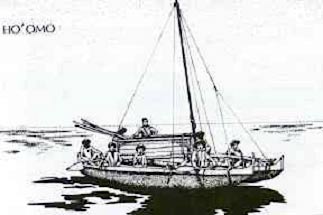|
Boats can be crazy
things
by Dan St. Gean
Boats can be crazy things. The boat-building
bug bit me a few years ago when I built a Guillemot Expedition.
I have really enjoyed using the boat, but I find that paddling,
while fun, didn’t scratch the itch quite enough. As a result,
I began a search for a shallow draft sailboat that would be multipurpose.
Those two words really did a number on a lot of designs that might
have suited. Even worse was my conversion to the dark side of
sailing—multihulls. Two summers ago I had the opportunity
to sail on Gilbert and Sullivan, a 36’ cruising cat with
a decided performance edge. 10-15 knots when the wind was up was
common; once we even saw 18! All while sailing level and not needing
to secure my open can of pop.

Shallow draft can be a boon—Here’s G& S at the
dingy dock…
With these experiences I began a search of home
building plans available to amateurs. Quite a few designs really
resonated with me, but the need to trailer really put a crimp
in my aspirations. As a teacher, the simple solution of just buying
a F24 was out of my financial reach, and I had to start thinking
budget level. With my love of camping, I was not confined to designs
that had fixed accommodations. Heck, I would have been happy with
a Hobie 21 Sport Cruiser! However, the 12K starting price was
more than I was willing to cough up for a toy, even one that consumes
as much thought and interest as sailing does. Thus my search was
narrowed even further.
What could I build that would allow me to use
it in the Fox river as a paddling craft, in local protected lakes,
in open water such as Lake Michigan, Lake Superior, and the ocean?
There were relatively few hits on my list now with the sort of
flexibility I was envisioning. However, I saw something online
that piqued my interest. Gary Dierking had designed a Hawaiian
outrigger canoe that was strip buildable, scalable to any length
up to 36’, and could be paddled and sailed. I sent off for
plans and got busy building as soon as the summer of ’04
began. With my free schedule in the summer coupled with the cool
and generally rainy weather up at the cabin in Wisconsin, I cranked
out a 21’ Ulua hull. I envisioned this being easily cartopped
(on a Suburban) to the local river for paddling with a partner,
and being able to sail either as an outrigger or as a trimaran.
Gary had already thought of the tri option and sent me some plans
for the akas (or iakos in Hawaiian canoe terminology). I also
found that Hawaiian canoes were traditionally lashed together
to form Hawaiian voyaging canoes, yes that’s right--the
ones in which the peoples of Oceania explored that side of the
world! And here I was only thinking of doing a little costal cruising
as the upper end of my ambition….

Gary with his 18’Ulua canoe in New
Zealand.
So my plan began to take shape
as the summer progressed. The summer of 2004 found the hull complete
less the sailing bits, but no outriggers or amas completed. School
and a host of other factors slowed my progress to a crawl, but
progress was once again made towards the end of September. The
surfboard style of construction began for the amas. I extended
the length to 16’ and upped their volume to handle the loads
imposed by the larger rig the extended hull would carry. Freestanding
masts would make the rigs easy to strike and have proven themselves
in many traditional vessels such as sharpies. 100 or more square
feet should do the trick for daysailing and add a row or two of
reef points for the possibility of venturing onto bigger waters.
Since Gary’s design has a covered bow and stern, I thought
I wouldn’t bother with any additional floatation, but have
since changed my mind. I plan on decking the 12’ cockpit
or adding a false floor with some big self-bailers to handle the
possibility of a breaking wave finding its way into the cockpit.
Another summer will hopefully find a second hull underway and
a Hawaiian voyaging canoe/catamaran underway.

Traditional Hawaiian Voyaging canoe

Smaller costal canoes—I’ll be using twin freestanding
rigs.
I don’t really feel constrained
to follow tradition here and I plan on having each canoe hull
sport a freestanding rig. In this way, each hull can be used with
a separate ama and aka. How’s that for a picture? Imagine
two outrigger canoes racing through the harbor. Or they can be
lashed together to form a pseudo Hawaiian voyaging canoe for costal
camping with room for two to four sailors. Since the latter hull
and subsequent catamaran are still a ways off, cruising with more
than two will have to be postponed until later. However the goal
for the current hull is to be sailing by Christmas break 2004.
The amas are being shaped right now and the akas will be made
up once they are finished. Isn’t building fun?
As a result of this focus on what
I want out of a boat, how it will be used, and what I can afford,
I believe that I am going to end up with a very versatile craft.
I can go for a paddle with a friend on the local river, go sailing
as an outrigger or trimaran, cruising with the trimaran option,
or eventually realize some costal camping ambitions, with the
tri or perhaps later the cat, that might not be so easily accomplished
with the smaller single hulled vessel. You know, those ancient
Hawaiians and their ancestors might have known a thing or two
about a thing or two.
Mahalo,
Dan St. Gean
|

